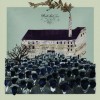 Among the current crop of instrumental bands that worship at the shrine of Cluster, Tangerine Dream, and Manuel Göttsching, Roll the Dice are perhaps the most underrated. In the wake of their enjoyable, self-titled debut on Digitalis last year, In Dust is a massive step forward—as striking and cinematic as the best synth-based albums I've heard in recent years.
Among the current crop of instrumental bands that worship at the shrine of Cluster, Tangerine Dream, and Manuel Göttsching, Roll the Dice are perhaps the most underrated. In the wake of their enjoyable, self-titled debut on Digitalis last year, In Dust is a massive step forward—as striking and cinematic as the best synth-based albums I've heard in recent years.
The liner notes of In Dust read like a dream for fans of this stuff. The album was recorded in Stockholm on purely analog equipment (in a nutshell, synthesizers and piano); mixed in a remote studio in Norway; mastered by Stefan "Pole" Betke in Berlin. There's a fantastic depth of sound throughout, and a constant sense of forward propulsion as the synths buzz, echo, shudder, pitch, throb and reverberate—subtly evolving, even as they circle around the same chords over and over and over. Listen, for instance, to the oddly uplifting "Way Out," which repeats for 11 minutes like a music box built around the same four chords, before dropping out in a flash—out of batteries, it seems.
Ultimately, "Way Out" is an anomaly; it floats, light as air, whereas the rest of In Dust is constructed around a dark, heady undercurrent. The propulsive "Maelstrom" is a textbook example, with its densely layered synth oscillations, muffled low-end pulse, and detached piano playing. There is no shortage of well-crafted drama as the album plays on; if anything, the tension has been cranked up significantly since last year's debut. Outside of Roll the Dice, Peder Mannerfelt played guitar and keys with Fever Ray a couple years back and his bandmate, Malcolm Pardon, cut his teeth on TV and film composition. Together, it was only a matter of time before the duo married a Kosmische pulse with cinematic grandeur this seamlessly.
If there's a parallel to be drawn, Roll the Dice's Olympic leap forward on In Dust is not unlike Emeralds' progression into mellifluous, hi-fi synth-scapes on Does It Look Like I'm Here?—perhaps that band's peak. In Dust is as sonically rich and sprawling as that album, if not as condensed; while Emeralds distilled their core sound into three- and four-minute "pop" songs, Roll the Dice take the opposite approach, generously stretching out. Nearly everything settles comfortably in between five and eight minutes, but never feels overcooked or dull. Rather, the length maximizes the widescreen nature of the songs, allowing the meticulous arrangements and production to become truly immersive.
Samples:
Read More

